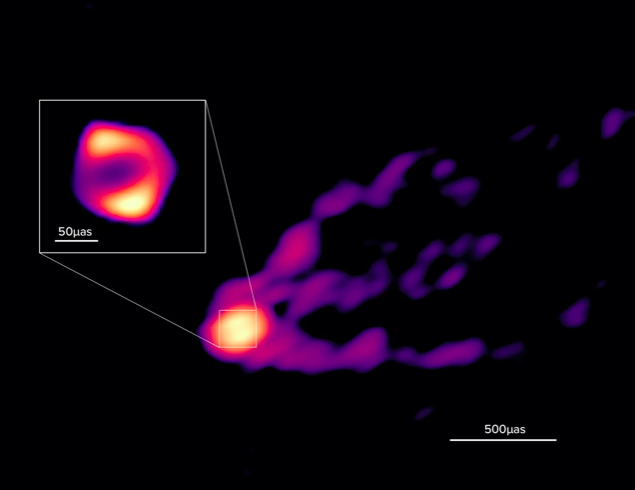How a black hole launches a jet
An international team of scientists have observed both the shadow of a black hole at the center of the Messier 87 (M87) galaxy and the powerful jet ejected from it in the same image for the first time. This breakthrough provides new insight into how black holes can produce powerful relativistic jets. Supermassive black holes are present in most galaxies, and while they typically absorb matter in their vicinity, they can also eject powerful jets of matter that extend beyond the galaxy. The mechanism for producing these jets has long puzzled astronomers.

Carolina Casadio, a researcher at the IA-FORTH, who participated in the publication, points out that “the mechanism for launching relativistic jets from voracious supermassive black holes, which are at the center of active galaxies, remains a mystery.” “The new image of M87,” explains Dr. Casadio, “provides an important new element in solving this mystery by revealing the connection between the jet and the emission region surrounding the black hole.”
The new image provides a panoramic view of a supermassive black hole that is 6.5 billion times the mass of the Sun, showing how the base of a jet is attached to matter swirling around the black hole. The black hole is located in the M87 galaxy, which is 55 million light-years away. The matter surrounding the black hole is swallowed through accretion, and the new image provides a clearer understanding of the physical processes near the black hole.
Ru-Sen Lu, the first author of the study and leader of a Max Planck Research Group at the Shanghai Astronomical Observatory of the Chinese Academy, is excited by the latest image of the black hole and its jet. “Previously, we had seen both the supermassive black hole and the jet far away from it in separate images, but now with the new image we have taken a panoramic view of the black hole together with its jet in a new observing band.” The matter surrounding the black hole is swallowed by a process called accretion. But no one has ever imaged this accretion flow directly. "The bigger and thicker ring we now see shows that the material falling into the black hole contributes significantly to the observed emission in the new image, which allows us to better understand the physical processes near the black hole," adds Dr. Lu.
The observations were made in 2018 with three different groups of telescopes: GMVA located in Europe and North America, ALMA in the Atacama Desert of Chile, and GLT in Greenland. The participation of ALMA in GMVA observations has substantially increased the sensitivity of detecting and imaging radio emissions from M87, providing a clearer understanding of the black hole's structure. Future observations with a network of telescopes distributed across the globe will continue to reveal how supermassive black holes produce powerful jets.
Article: R. Lu (including C. Casadio) et al. "A ring-like accretion structure in M87 connecting its black hole and jet", Nature, Vol. 616, pages 686–690 (2023)
